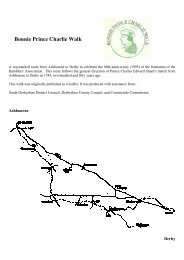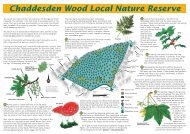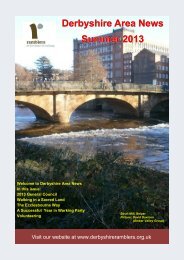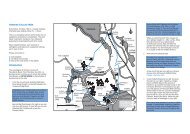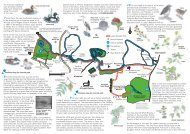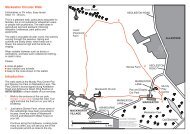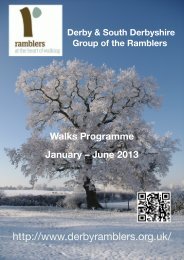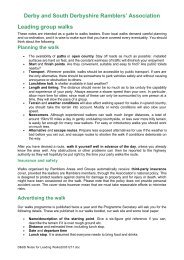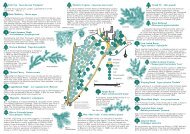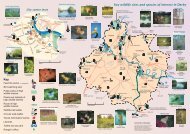Derbyshire Area News - Derby and South Derbyshire Ramblers
Derbyshire Area News - Derby and South Derbyshire Ramblers
Derbyshire Area News - Derby and South Derbyshire Ramblers
- No tags were found...
You also want an ePaper? Increase the reach of your titles
YUMPU automatically turns print PDFs into web optimized ePapers that Google loves.
<strong><strong>Derby</strong>shire</strong> <strong>Area</strong> <strong>News</strong>—Winter 2011/12 2012/13Council to the archives <strong>and</strong> has not been catalogued yet. I was looking for the recordsassociated with the 1949 National Parks <strong>and</strong> Access to Countryside Act. TheMatlock office has a folder for each <strong><strong>Derby</strong>shire</strong> parish containing correspondence <strong>and</strong>notes about footpaths from the early 1950s until the 1980s. There are also copies ofthe maps used by parish councils in 1950 to map their paths <strong>and</strong> the survey forms foreach footpath. The only information I have not been able to find are the records of theappeals meetings in which l<strong>and</strong>owners, ramblers <strong>and</strong> others involved could raise objectionsto the routes added to the draft Definitive Map.The details in the Catton folder were sparse but I was not surprised to see that the1949 survey paperwork had been filled in by the owner of Catton Hall, George HenryAnson, who was chairman of the parish meeting. This element was a weakness ofthe 1949 Act as the returns for local paths was usually carried out by the parish councilwhich in the post war period continued to be dominated by local l<strong>and</strong>owners whowere usually not keen to see footpaths going across their l<strong>and</strong>. And so this was thecase in Catton where three tiny footpaths were added (one more was added later bythe local surveyor) on the margin of the parish <strong>and</strong> none of them went anywhere nearthe attractive areas of the estate <strong>and</strong> house.I have found that owners of l<strong>and</strong>ed estates often describe footpaths close to theirproperties as “workmen’s routes” which had never been walked by any members ofthe public. I have come across this in other areas of the East Midl<strong>and</strong>s including IsleyWaklton <strong>and</strong> Buckminster in Leicestershire where the lords of the manor had tried toremove as many paths as they could from the map with a host of other excuses includingcalling them “hunting roads”. Further problems were caused when the parishcouncils sent their returns in the early 1950s to the County Councils which were dominatedor heavily influenced by the l<strong>and</strong>ed gentry. In <strong><strong>Derby</strong>shire</strong> these included theDuke of Devonshire (Chatsworth) <strong>and</strong> in Leicestershire, the Duke of Rutl<strong>and</strong>; bothhostile at the time to walkers.In the Catton folder of correspondence there were two intriguing letters (written in1966) involving a footpath that ran south of Catton to the Warwickshire border <strong>and</strong>beyond. The footpath was named after a 17th century poet who frequently stayed inthe area; it was known as Dryden’s Walk. The author of the letters wanted the Walkto be added to the Definitive Map <strong>and</strong> pointed out that the route was on a series ofOrdnance Survey maps even up until the 1950s.The author of the letters requested that contact be made with the County Archivist,whether this happened or not I cannot establish but a note on one of the lettersstates, “not on definitive, not claimed by parish, no reps (?)”. There is a further note inthe correspondence stating that the matter be left “for a rainy day” as they had other,more pressing things to deal with. The County Council surveyors department obviouslydid some work on the issue as there are further notes about the OS mapswhere this route was recorded. However, nothing came of the request <strong>and</strong> Dryden’sWalk was never added to the Definitive Map. Parts of it still seem to exist today <strong>and</strong>mention is made of it in several history books but certainly at the Catton end all signsof it have gone.Who was the writer of the letters to the County Council? Initially I was stumped asthey were sent from a location (perhaps a school) in Birmingham which no longer26



